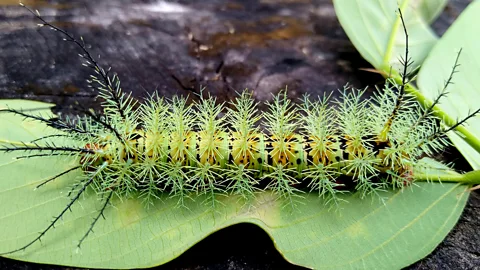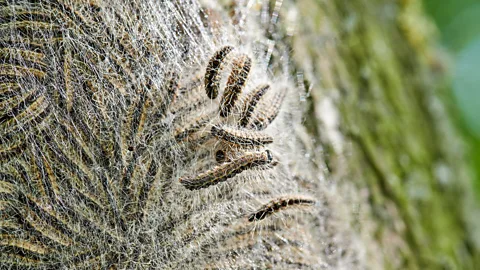
Some caterpillars have extremely potent venom. Using them could help us design new drugs.
When you think of poisonous animals, caterpillars probably aren’t the first thing that comes to mind. Snakes, of course. And scorpions and spiders. But what about caterpillars?
Yes, that’s right. It turns out that the world is home to hundreds—maybe thousands—of venomous caterpillar species, and at least some of them are so toxic that they can kill or permanently injure humans. That’s why scientists should study them. But caterpillars may also contain a large number of medically useful compounds in their toxic secretions.
“Can we get to the point where we can get useful things out of their venom? “Absolutely,” says Andrew Walker , an evolutionary biologist and biochemist at the University of Queensland in Australia. “But there’s a lot of fundamental work to do first.”
Caterpillars are the larval stage of the order Lepidoptera, butterflies and moths. They are just one of many little-known groups of venomous animals. (Venom is a poison that is intentionally injected into another animal, while the poison remains passively in the organism’s body, waiting to infect a potential predator.) Biologists estimate that venom has evolved at least 100 times across the animal kingdom.
Many venoms are complex, some containing more than 100 different compounds. They also have incredible diversity. “No two species have the same venom repertoire,” says Mandë Holford , a venom scientist at Hunter College and the American Museum of Natural History in New York. “That’s why it’s important to study as many species as possible.”

In fact, studying venoms may be a better way to find new drug candidates than starting from scratch, because they contain molecules that have been fine-tuned over the ages to target specific biological processes in their prey. “They’ve evolved over millions of years, they’ve been tested in the wild, and we know they work,” says Holford. “When we try to develop them ourselves in the lab, the success rate is much lower.”
Yet most venomous groups remain largely off the radar of scientists. “We know a lot about the venom of snakes, scorpions, and spiders,” says Nicholas Casewell , a venom biologist at the Liverpool School of Tropical Medicine in the United Kingdom. “But there are many groups of venomous animals that remain largely unexplored.”
Walker, who wrote about venomous butterflies in the 2025 Annual Review of Entomology, said the caterpillars deserve more attention. Although only about 2% of caterpillar species have venom, Walker estimates that they are widely distributed throughout the butterfly evolutionary tree. This pattern means that venom has likely evolved independently multiple times within the group, potentially leading to extraordinary chemical diversity.
These few toxic individuals are enough to make the poisonous caterpillar a serious public health problem, at least in some parts of the world.
This poisonous caterpillar, a member of the genus Lonomia in South America, has a venom similar to that of a snake, capable of disrupting blood clotting. Some other species have venom that causes chronic, long-lasting inflammatory problems, and a few have caused abortions in horses.
That small number of individuals is enough to make the caterpillars a serious public health problem, at least in some parts of the world, Walker said. “They don’t kill people as often as scorpions and snakes, but compared to spiders, there’s not a huge difference in the health risk.” These concerns have prompted some researchers to study the biology of the potentially lethal Lonomia venom and develop serums to treat those affected.

Walker says that while some other types of caterpillar venom have been studied at least a little, most remain largely unexplored—and medicine may be lagging behind. For example, he notes, most butterfly venoms are painful, sometimes painful enough to require opioid painkillers. This isn’t surprising, since pain is a great way to deter predators—but it also allows scientists to use venom as a probe to identify pain pathways in the body and pain receptors in laboratory animals and, potentially, humans. This could lead to the development of new drugs.
Research into caterpillar venom is still so scant that no new drugs have been developed, but the venoms of other creatures have given rise to some important therapies. There are blood pressure medications and anticoagulants inspired by snake venom, for example , and the precursor to the groundbreaking new drug semaglutide—better known by its brand names Ozempic and Wegovy—is based on a molecule extracted from a venomous lizard, the Gila monster.
Thanks to advances in molecular biology and bioinformatics, the venom of all animals, including caterpillars, is becoming easier to study — and that could soon be a big step forward, says Casewell. “It’s like a treasure trove waiting to be discovered.”


